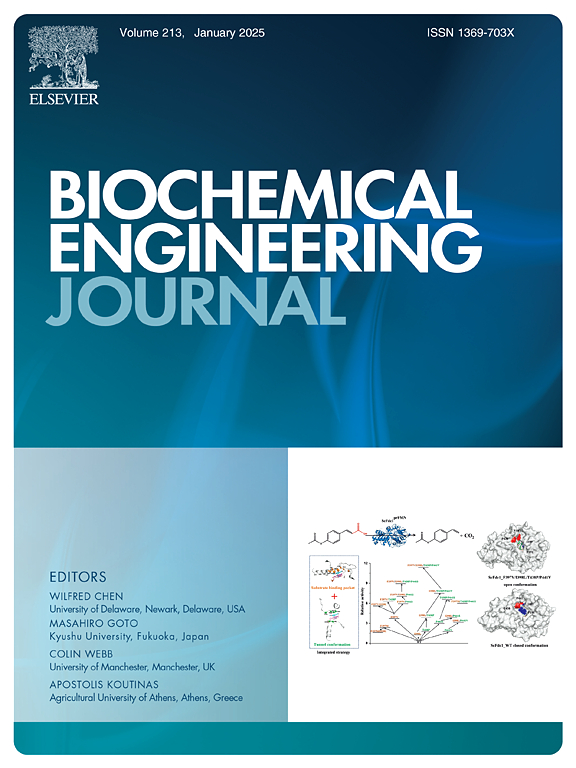Heterologous expression of algal fucosyltransferases and sulfotransferases in Escherichia coli
IF 3.7
3区 生物学
Q2 BIOTECHNOLOGY & APPLIED MICROBIOLOGY
引用次数: 0
Abstract
Alternative to classical production of fucoidans, enzymatic synthesis has been proposed especially following genomic and bioinformatic investigations in Ectocarpus siliculosus and Saccharina sp. The present research aimed to assess the activity of four putative algal enzymes, including fucosyltransferases (FucTs_21 and FucTs_50) and carbohydrate sulfotransferases (STs_32 and STs_283) expressed in E. coli BL21 (DE3) for future application in lab-synthesized fucoidans. A specific activity of 0.47 pmol.min−1.µg−1 was observed for FucTs_50 in the Glycosyltransferase activity assay, while multiplexed capillary electrophoresis (MP-CE) revealed that almost 32 % of GDP-L-fucose was affected. Additionally, the Universal Sulfotransferase Activity Kit was used to evaluate STs, and the results indicated that STs_283 and STs_32 exhibited specific activities at 2.29 and 2.38 pmol.min−1.µg−1, respectively. The results indicated correctly folded active enzymes with binding sites specific to their corresponding substrates.
藻类聚焦转移酶和硫转移酶在大肠杆菌中的异源表达
在基因组学和生物信息学研究之后,人们提出了一种替代传统生产岩藻多糖的酶法合成方法。本研究旨在评估大肠杆菌BL21 (DE3)中表达的四种可能的藻类酶的活性,包括聚焦转移酶(FucTs_21和FucTs_50)和碳水化合物硫转移酶(STs_32和STs_283),以便将来在实验室合成岩藻多糖的过程中应用。比活度为0.47 pmol.min−1。在糖基转移酶活性测定中,FucTs_50的浓度为µg−1,而多重毛细管电泳(MP-CE)显示,几乎32% %的GDP-L-病灶受到影响。此外,使用通用硫转移酶活性试剂盒对STs进行了评估,结果表明STs_283和STs_32在2.29和2.38 pmol.min−1时具有特异性活性。分别µg−1。结果表明,正确折叠的活性酶具有相应底物特异性的结合位点。
本文章由计算机程序翻译,如有差异,请以英文原文为准。
求助全文
约1分钟内获得全文
求助全文
来源期刊

Biochemical Engineering Journal
工程技术-工程:化工
CiteScore
7.10
自引率
5.10%
发文量
380
审稿时长
34 days
期刊介绍:
The Biochemical Engineering Journal aims to promote progress in the crucial chemical engineering aspects of the development of biological processes associated with everything from raw materials preparation to product recovery relevant to industries as diverse as medical/healthcare, industrial biotechnology, and environmental biotechnology.
The Journal welcomes full length original research papers, short communications, and review papers* in the following research fields:
Biocatalysis (enzyme or microbial) and biotransformations, including immobilized biocatalyst preparation and kinetics
Biosensors and Biodevices including biofabrication and novel fuel cell development
Bioseparations including scale-up and protein refolding/renaturation
Environmental Bioengineering including bioconversion, bioremediation, and microbial fuel cells
Bioreactor Systems including characterization, optimization and scale-up
Bioresources and Biorefinery Engineering including biomass conversion, biofuels, bioenergy, and optimization
Industrial Biotechnology including specialty chemicals, platform chemicals and neutraceuticals
Biomaterials and Tissue Engineering including bioartificial organs, cell encapsulation, and controlled release
Cell Culture Engineering (plant, animal or insect cells) including viral vectors, monoclonal antibodies, recombinant proteins, vaccines, and secondary metabolites
Cell Therapies and Stem Cells including pluripotent, mesenchymal and hematopoietic stem cells; immunotherapies; tissue-specific differentiation; and cryopreservation
Metabolic Engineering, Systems and Synthetic Biology including OMICS, bioinformatics, in silico biology, and metabolic flux analysis
Protein Engineering including enzyme engineering and directed evolution.
 求助内容:
求助内容: 应助结果提醒方式:
应助结果提醒方式:


